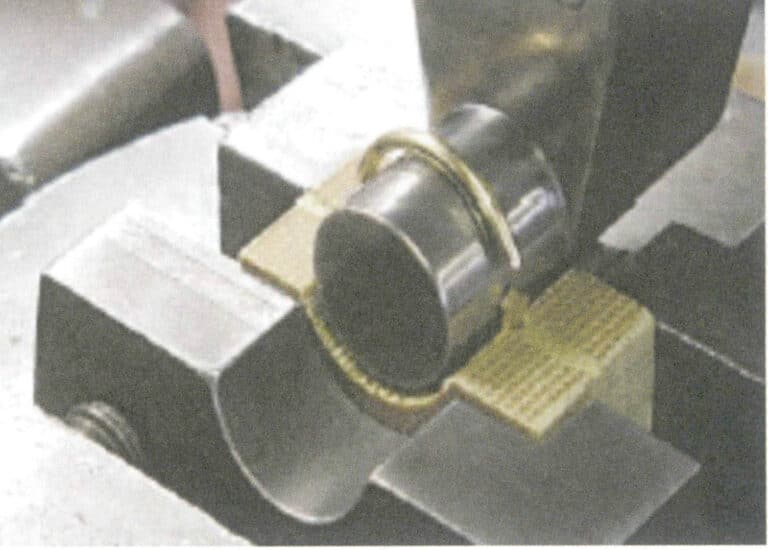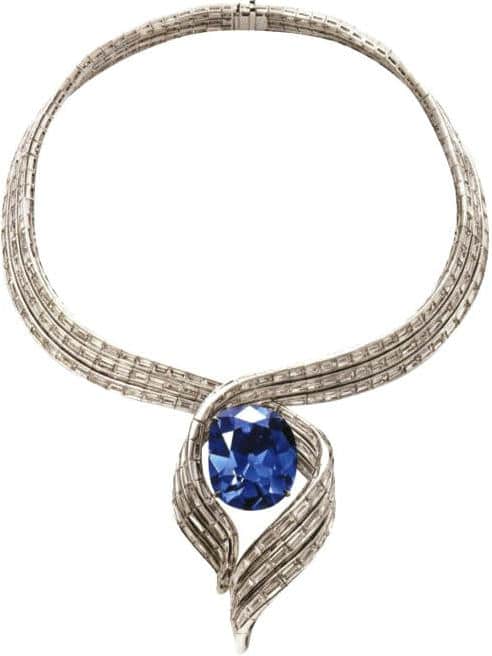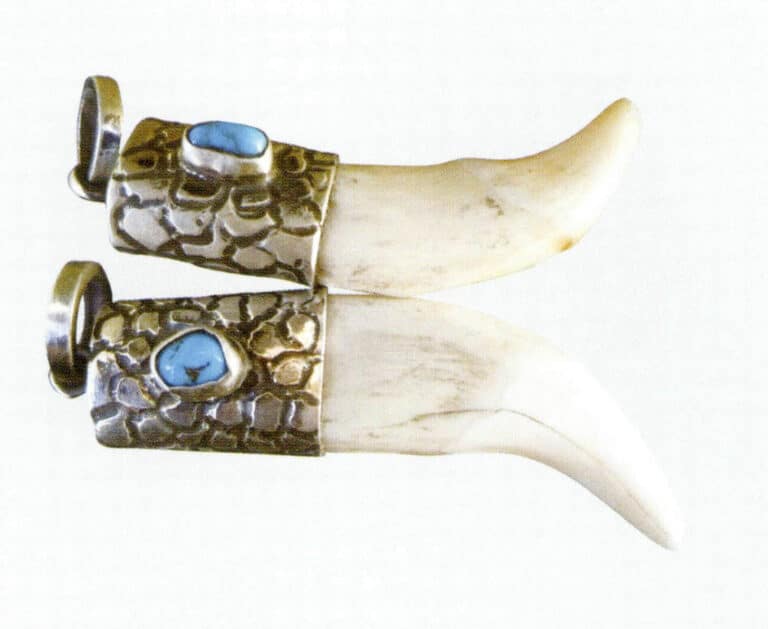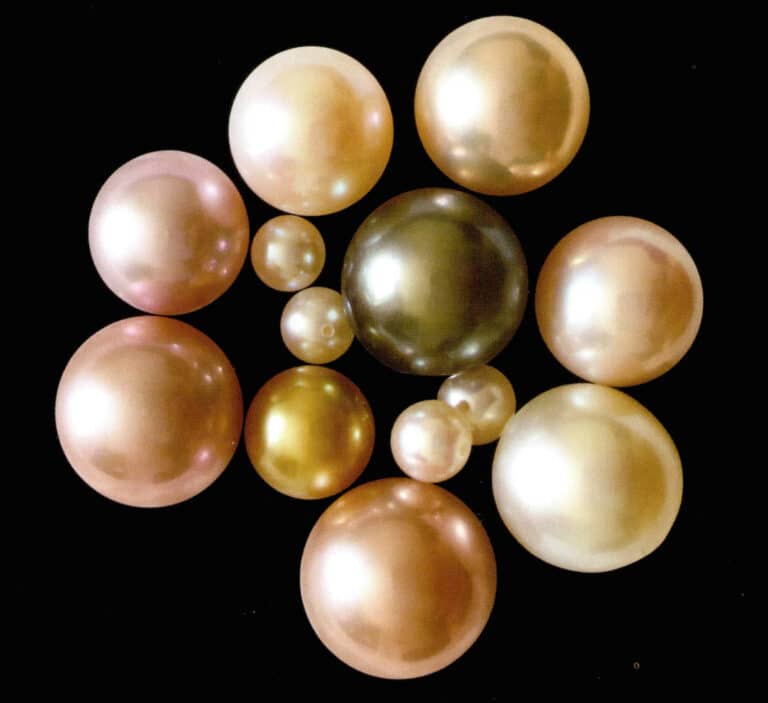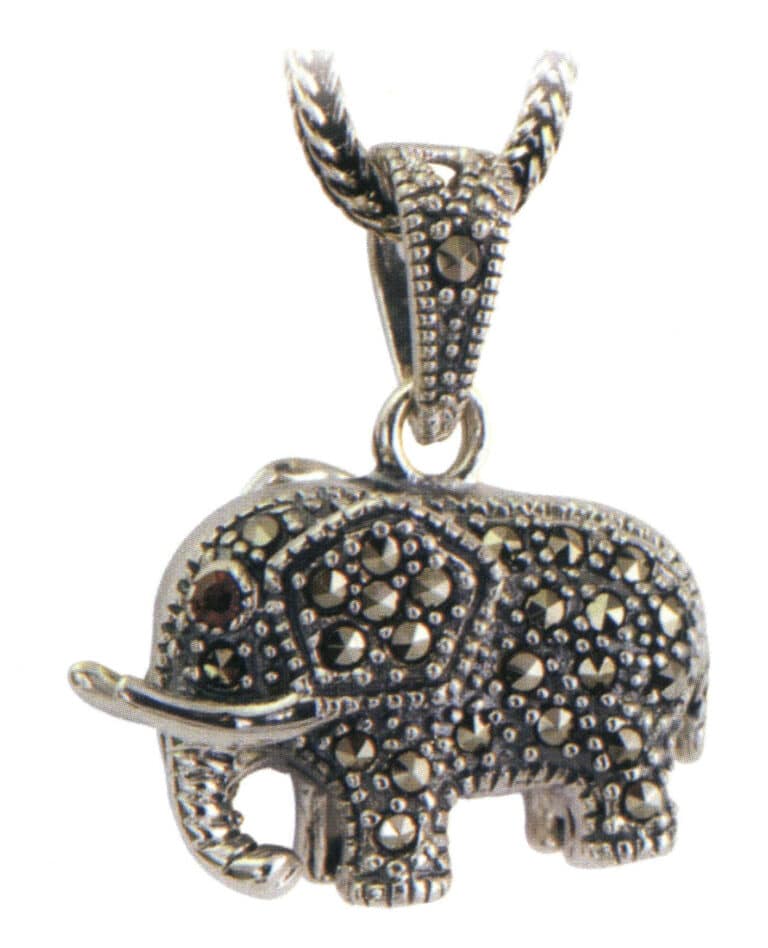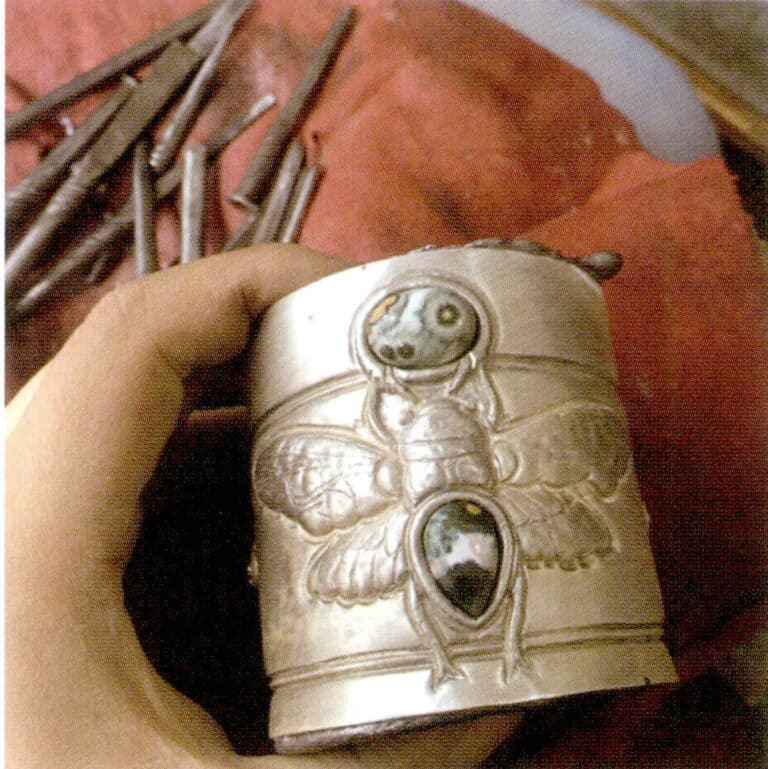What Makes Wooden Ornaments So Unique: Exploring Rare Woods & Craftsmanship
Discover the Allure of Wooden Ornaments: Crafting Beauty from Nature
Wood comes from nature and has always been used in creating crafts. With people’s return to simplicity and their admiration for nature, wood has begun to be used in producing accessories, achieving a good market effect. These accessories, made entirely from natural wood materials, are aesthetically pleasing and cater to people’s pursuit of environmental protection, fashion, and individuality, becoming a new favorite in the market.
There are many types of wood, and the wood used for ornaments is generally selected from less common and more precious varieties, such as agarwood, rosewood, dark wood, sandalwood, Chinese nanmu, and petrified wood.

Agarwood bracelet
Obsah
Section I Agarwood and Accessories
1. Introduction to Agarwood
Agarwood is known as the “diamond among plants.” It gathers the spiritual energy of heaven and earth, combines the essence of the sun and moon, and is refined by time, having been regarded as the foremost among all fragrances since ancient times. The “sandalwood, agarwood, and dragon’s blood” often mentioned by ancient people refers to agarwood. As a bearer of traditional Chinese culture, agarwood now attracts more and more people to appreciate and study it. It can be a decorative accessory to enhance personal charm and be used for incense to soothe the mind and relieve stress. It is also a very precious medicinal material.
Agarwood and agarwood tree are two different concepts. Agarwood tree refers to the host of agarwood, which belongs to the dicotyledonous plant family Thymelaeaceae and is an evergreen tree. In some places, this tree is directly called agarwood tree, and the part that has not formed resin is called agarwood timber. Agarwood trees mainly grow in subtropical regions, such as Guangdong, Guangxi, Hainan, and Taiwan, as well as in China and Southeast Asian countries like Vietnam, Malaysia, Indonesia, and the Philippines. When the surface or interior of an agarwood tree forms a wound, resin accumulates around the injured area to protect it. When the concentration of accumulated resin reaches a certain level, this part can be harvested as usable agarwood. However, wounds are not the only reason for resin accumulation; agarwood resin can also naturally form in the tree’s interior and decayed areas. Agarwood is a mixture of woody components containing agarwood resin and a fatty component known as “agarol.” In ancient China, agarwood was classified as “wood” and referred to as “honey wood” or “fragrant wood.”
2. Conditions for the Formation of Agarwood
The formation of agarwood is very rare, and the requirements for natural conditions are extremely strict; at least the following conditions must be met.
(1) To form agarwood, there must first be agarwood trees, a prerequisite for resin formation.
The four major tree species of the burseraceae, the lauraceae, and the thymelaeaceae and euphorbiaceae can all produce agarwood, among which the highest quality agarwood often comes from the agarwood tree of the thymelaeaceae. Most of the agarwood seen on the market today is produced by the agarwood tree of the thymelaeaceae. The process of agarwood formation in the agarwood tree is long, and the requirements for the conditions of agarwood formation are particularly high. Hence, the proportion of agarwood formation in this tree species is relatively low.
The agarwood tree of the thymelaeaceae family has very high requirements for its growing environment, including soil, temperature, and humidity. Only Southeast Asia’s warm and humid regions are suitable for its growth. Once the temperature in its environment drops below -2℃, the survival of the agarwood tree will be threatened, and it will be difficult for it to survive even if transplanted to other places. Moreover, this type of tree has brittle wood, and its branches are easily broken, which can lead to injury or even death, making it hard to survive in areas with strong winds and sand. For an agarwood tree to produce satisfactory agarwood, it must have the aforementioned living conditions and possess mature and well-developed resin glands, which generally only occur in trees that have grown for several decades. Due to its poor adaptability to the environment, wild agarwood trees typically have a lifespan of only one to two hundred years at most.
(2) The complex process of resin production – wounds combined with a long aging process
That is the beginning when an agarwood tree finds a suitable environment to grow and mature. Next, it needs to wait for various coincidences in nature to give it a chance to produce resin.
The agarwood tree, after suffering some damage, will form wounds. These damages include lightning strikes, erosion from wind and sand, bites from insects and ants, cuts from knives or axes, or animal injuries. With these wounds, the agarwood tree may have the possibility of producing fragrance, but this is not absolute. If these wounds do not heal quickly, the surrounding tissue may become infected with bacteria. If lesions occur, the tree sap in the agarwood tree will begin to function like the human immune system, mutating to form a paste-like mass of oil. This is to prevent the woody tissue from rotting due to lesions. This mass of oil will continuously spread along the woody vessels of the agarwood, and after a period of maturation, it will form a mixture of oil and wood. This process is the process of agarwood formation.
(3) Continuing the incense – Various changes of the aromatic part
The agarwood oil (agarol) in agarwood is active and will change over time, and with environmental changes, its characteristics will also change accordingly. As a result, after the agarwood tree successfully produces resin, the following situations will mainly occur.
- Agarwood oil adheres to the inside of agarwood to form fragrance, and the agarwood tree, as a carrier, provides various conditions for the continuous growth and diffusion of agarwood fragrance, such as nutrients. Therefore, the agarwood oil inside the agarwood will continuously diffuse, and the quality of the oil will improve.
- The aromatic part has left the agarwood and fallen into muddy water or soil. At this point, there is no tree body to provide nutrients for the aromatic part, the aromatic part will stop spreading, and its shape, color, etc., will also change with the environment. If agarwood remains in such an environment for a long time, it will deteriorate or weather and eventually disappear. However, if the fallen aromatic part has a high oil content, the shell can protect the internal oils after weathering, preserving the internal oils.
- The aromatic part still clings to the agarwood, but the agarwood eventually dies and decays. The residual aromatic part within the tree body may continue to grow for some time or stop growing directly, depending on the different conditions of the agarwood’s decay. Regardless of the aromatic part, the active oils inside will be preserved for some time, during which the agarwood with a higher oil content will continuously change its appearance and form various scents over time and with changes in the environment.
3. The Classification of Agarwood
Various classification methods for agarwood can be divided based on its formation method, quality, origin, fragrance, and other aspects.
(1) Classification based on changes in aromatic part
The aromatic part in the living agarwood tree is “green agarwood.” In contrast, the fragrant substance obtained from the peeling of the agarwood tree or a dead agarwood tree is called “ripe agarwood,” also known as “matured incense” or “dead incense.” The distinction between the two is usually made based on fragrance and appearance.
The fragrance of “green agarwood” has a fresh sweetness and coolness, but due to the short time it takes for the incense to form, the internal moisture has not dried, and the aging of the resin is too low; it often carries a certain degree of astringent taste and excessive moisture. The fragrance of “ripe agarwood” leans more towards a rich honey and milk flavor, but because its body has been in the soil for a long time, it contains more impurities, or the woody components within the incense have undergone mold changes in the environment, it often carries a certain degree of moldy and sour taste.
The oil of “green agarwood” diffuses and grows along the wooden conduits, so its oil lines are more pronounced, closer to the wood, and when shaved with a knife, it has a more obvious wooden feel. The growth time of “ripe agarwood” is generally longer and is greatly affected by the environment; its surface oil lines are not very prominent, and it usually has a more brittle texture, giving a crumbly feel when shaved with a knife.
(2) Classification of the quality of resinous oils
Suppose the wood’s internal sap is abundant and nutrient-rich when a wound on an agarwood tree reaches deep into the wood. In that case, it is often easier to produce agarwood with a darker color and richer oil content, referred to as heartwood oil agarwood. Heartwood oil agarwood has dense oil lines, mostly black oil. When the oil content reaches a certain level, it will sink into water, which is considered high-quality agarwood. Different positions of agarwood, times, and sizes of wounds, among other external factors, can all affect the form of heartwood oil agarwood.
If the damage to the tree is only on the surface of the bark, the agarwood oil will flow along the bark’s surface vessels and remain attached to the bark surface, which is known as edge bark oil agarwood. Edge bark oil agarwood often has a thinner layer of oil, appearing in thin sheets, making it difficult to form a thick aromatic part. Once heated, the oil will quickly evaporate completely. Edge bark oil agarwood can also be divided into oil-exuding agarwood and bark-resin agarwood, where oil-exuding agarwood is close to the woody part, and bark-resin agarwood is directly formed on the bark.
(3) Classification based on the morphological characteristics of the plant
Affected by various external factors, the agarwood tree’s agarwood can have different physical characteristics, which can be divided into the following typical varieties.
① Stump agarwood. When axes or saws injure an agarwood tree, or the tree body is broken transversely, the resulting wounds are often planar. Such large-area wounds form a thin, dense, oily aromatic body called stump agarwood. Its characteristics include an irregular shape and flat aromatic body. Since the wounds of stump agarwood are cross-sectional to the tree body, its oil lines do not distribute linearly along the tree’s vascular system but appear as point-like, planar distributions similar to the cross-section of the vessels.
② Insect-bored agarwood. The fragrant body produced from the wounds of the agarwood tree caused by insect bites is called insect-bored agarwood, which have a unique shape and generally spiral. The wounds from insect bites usually have a single insect hole, where the insect bites horizontally or diagonally through the agarwood tree’s ducts, causing the agarwood oil to form around the insect path. Each piece of insect-bored agarwood can at least be found with one insect hole, which is a significant characteristic of insect-bored agarwood.
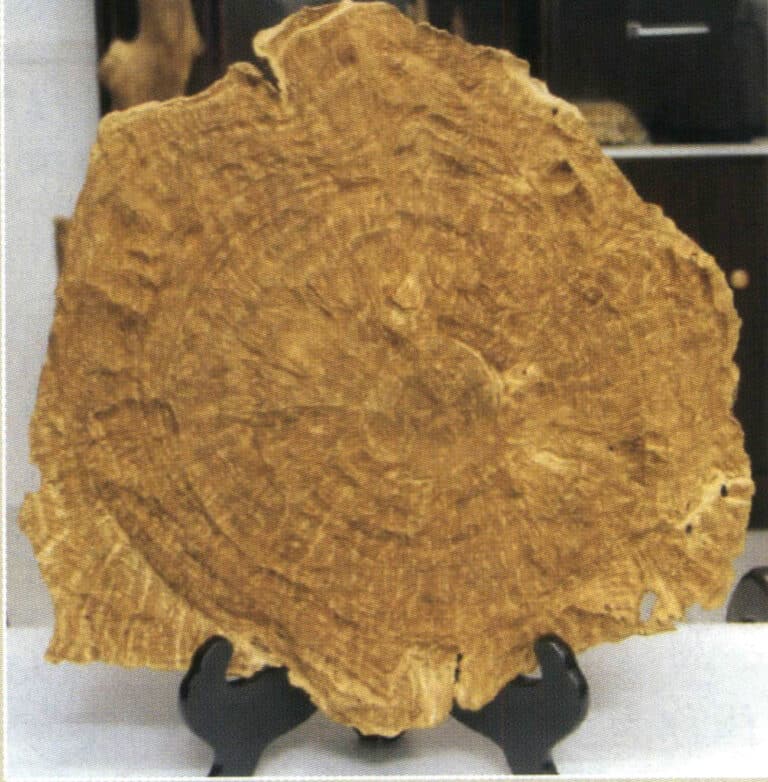
Stump agarwood

Insect-bored agarwood
③ Fallen-trunk agarwood. The term “fallen-trunk agarwood” comes from a special situation during the collection of agarwood by incense farmers. The agarwood tree has long been dead, lying in the soil or swamp, but the aromatic body itself still exists within the tree. The woody components of the tree have decayed and weathered under the action of microorganisms and external environmental influences. Still, the aromatic body has been preserved intact, and its shape resembles a fallen rack. Hence, it is called fallen-trunk agarwood.
④ Water-sunken agarwood (also known as Water Pattern Agarwood, Water Grid Agarwood). It is a term created by incense farmers, referring to aromatic part that has separated from the tree and entered moist mud or swamps, maturing to form agarwood. Water-sunken agarwood is often dark in color, and due to the humid environment in the later stages, it is less affected by weathering, making the oil patterns visible. Water-sunken agarwood has a hard texture and great toughness, and the aromatic body is generally quite thick.

Fallen-trunk agarwood
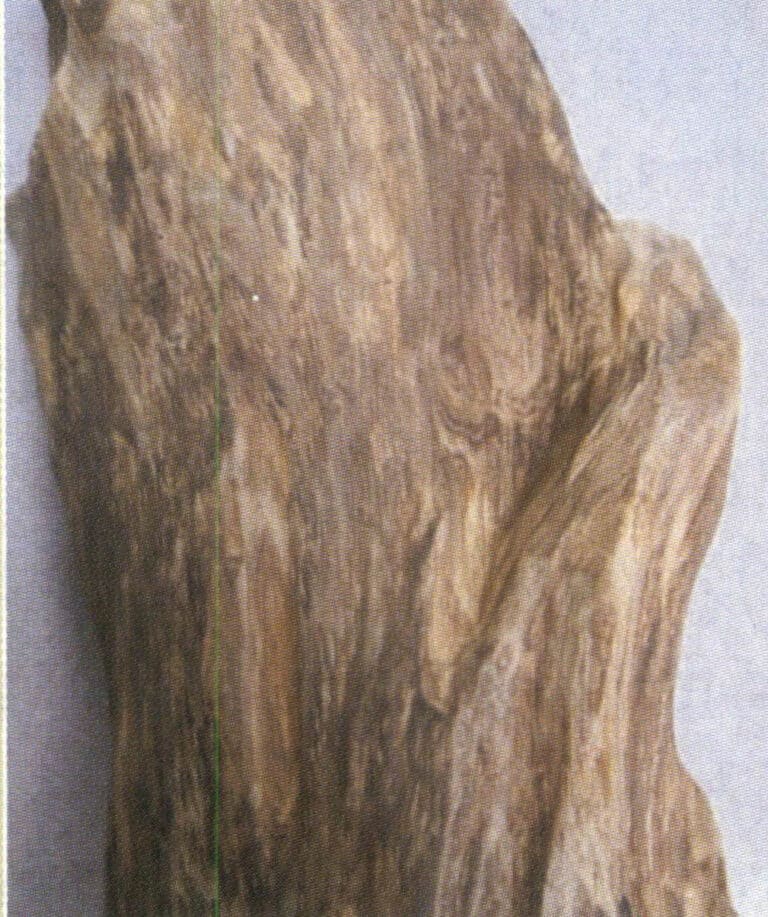
Water-sunken agarwood
⑤ Earth-aged agarwood. It is also a type of mature agarwood. When the aromatic body falls off, or the agarwood tree dies naturally, the aromatic body falls into drier soil. After that, the aromatic body is greatly affected by weathering, forming a loose and porous texture called earth-aged agarwood. When buried in the soil, its color will be influenced by the soil quality and the color of its impurities. The appearance of earth-aged agarwood varies according to the degree of maturation and weathering. Those with less weathering have a hard exterior and a thick aromatic body; those with severe weathering usually have a porous surface and a brittle texture.
⑥ Ant-nest agarwood. It is very similar to insect-bored agarwood, also formed by insect bites and bee stings, but ant-nest agarwood generally refers to one with a higher grade of oil and is older. Ant-nest agarwood’s fragrance is generally sweeter and richer than insect-bored agarwood, while insect-bored agarwood has a cooler scent.

Earth-aged agarwood
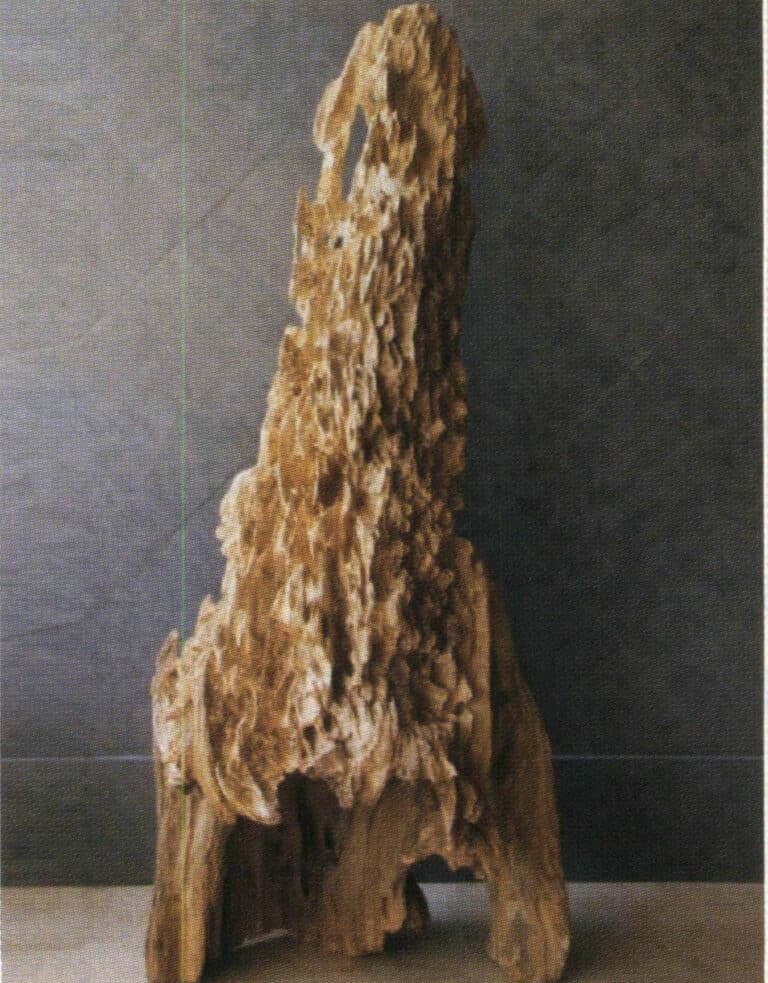
Ant-nest agarwood
⑦ Ultimate agarwood. This is the highest grade of agarwood and the most dazzling star among spices. The oil color of Kyara is very rich, mainly green oil, but also includes black oil, yellow oil, red oil, and purple oil. It can be divided by color into Kingfisher Green Kyara, Orchid Purple Kyara, Golden Veined Kyara, Sugar-Brown Kyara, Iron-Black Kyara, etc.
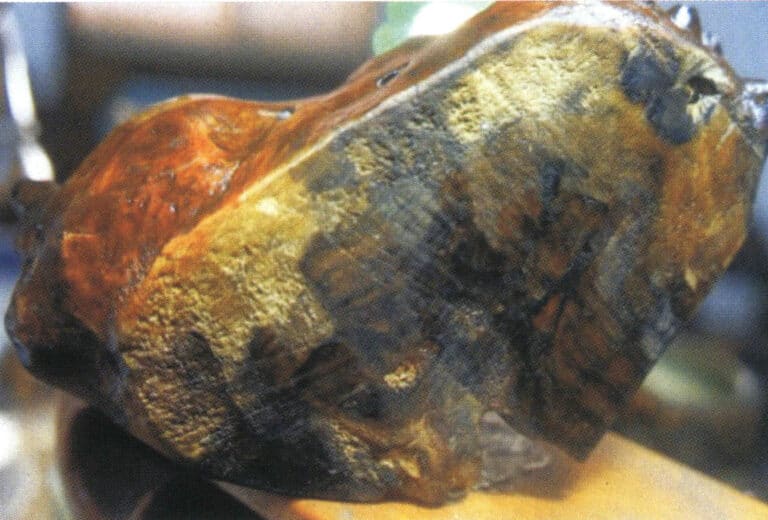
Ultimate agarwood
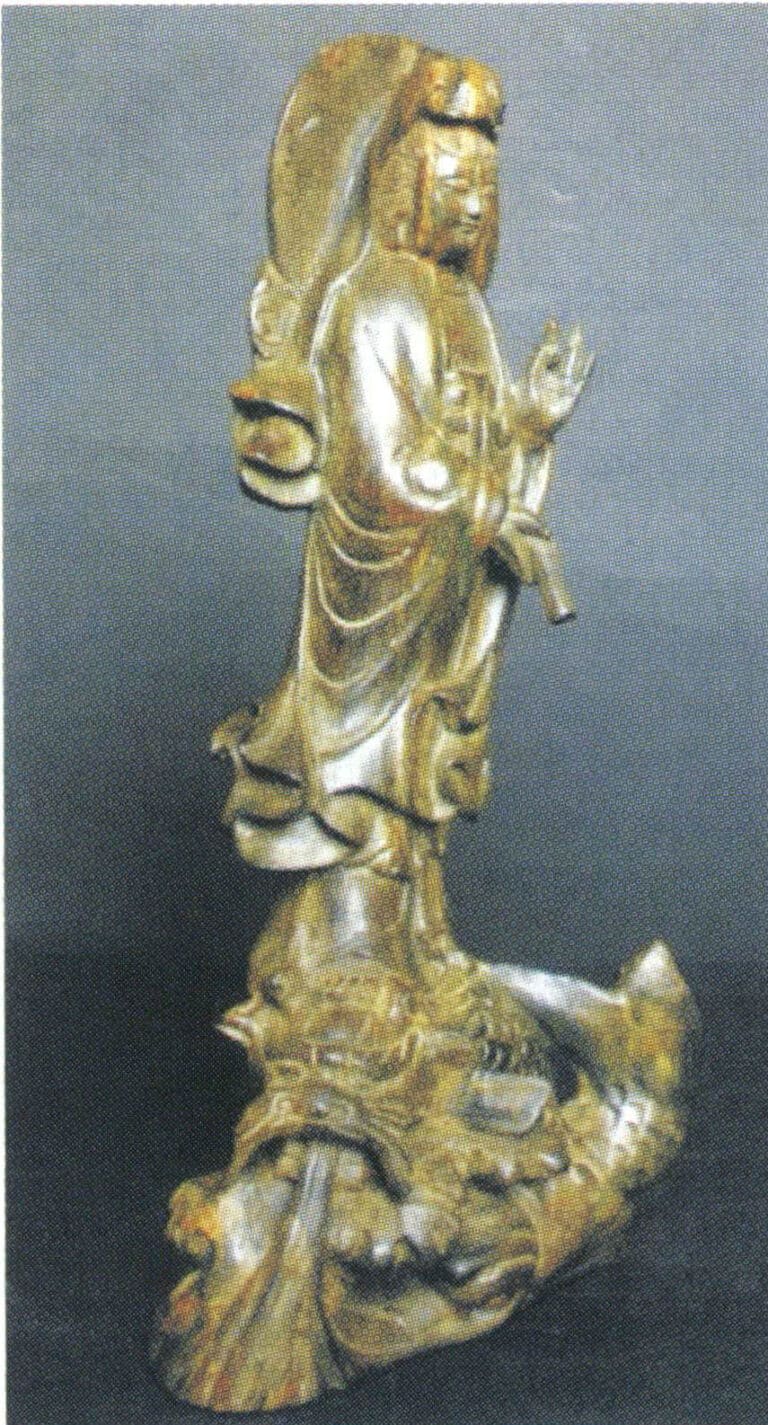
Ultimate agarwood carving of Guanyin
(4) Artificial Agarwood
With the increasing popularity of the agarwood market, natural wild agarwood has been extensively harvested, making natural resources increasingly scarce. In Southeast Asia, one of the jobs of the indigenous people living in the forests is to collect agarwood, and they will randomly make wounds on the agarwood tree with a fragrance knife to artificially create conditions for the tree to produce resin, which can provide more resources and conditions for future harvesting. This behavior does not belong to artificial agarwood; the resin produced is still wild because it only triggers the conditions for resin production, but the process of resin formation is still natural, without artificial catalysis or interference. However, this traditional and inefficient method of resin production can no longer meet the demands of the agarwood market, and the huge commercial interests have led to the proliferation of “artificial agarwood.” Artificial fragrance production involves artificially drilling holes in the agarwood tree, hammering in nails, burning, applying fungi, and using agarwood-inducing agents to promote resin production. Of course, not all artificial agarwood is of poor quality; some have a decent oil content. However, some unscrupulous merchants use very poor methods to produce fragrance, utilizing chemical scents to create resin, and some only have a superficial layer of resin. At the same time, the inside is all white wood. This type of artificial agarwood not only has an unpleasant smell but is also harmful to the body, and its price is much lower than that of pure natural agarwood products.
4. Agarwood Craft Ornaments
High-quality agarwood is often used for religious offerings and carvings. Due to the requirements for the volume and quality of its raw materials, the carved works are almost all exquisite artworks with high collectible value, favored by business people and religious figures, such as agarwood carvings of Guanyin.
With the rise of Buddhism and people’s pursuit of fashion and taste, agarwood accessories have also entered the lives of ordinary people, such as agarwood pendants and agarwood bracelets. It should be noted that since agarwood is classified as a controlled plant, genuine agarwood accessories are very expensive. Although similar in appearance and emitting fragrance, most cheap agarwood accessories sold on the market have significant differences in material selection and craftsmanship compared to genuine agarwood.
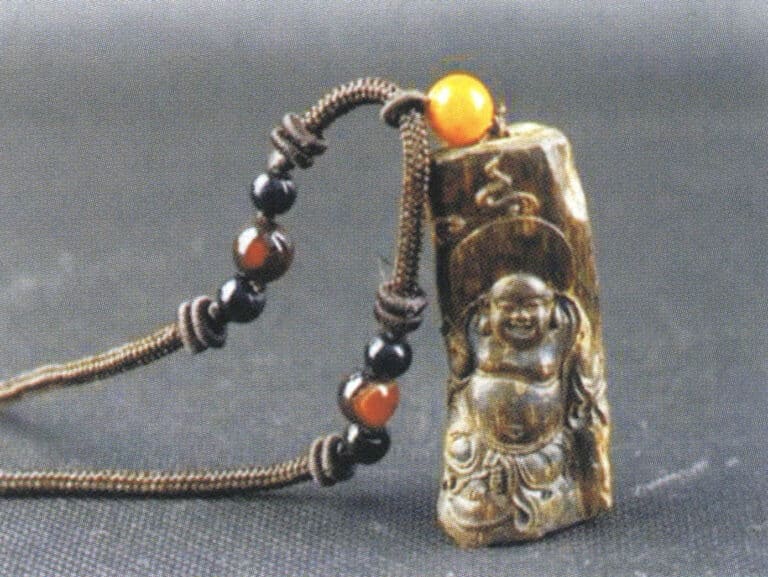
Agarwood pendant

Agarwood bracelet
Section II Huanghuali Wood and Its Ornaments
1. Introduction to Huanghuali
Huanghuali, scientifically known as Dalbergia odorifera, has varieties based on its origin, including Hainan Huanghuali, Vietnamese Huanghuali, Laotian Huanghuali, African Huanghuali, and Brazilian Huanghuali, with Hainan Huanghuali being the most precious. The wood grain of Hainan Huanghuali resembles flowing clouds and water, has a smooth texture, is elegant and soft in color, and carries a refreshing fragrance. Its heartwood is hard and dense, with good processing performance. Due to its rarity, it is known as the “giant panda of plants” and enjoys the reputation of being “the most expensive wood in China.” It is highly regarded historically and in modern times, standing alongside Red Sandalwood, Wenge, and Ceylon ironwood as one of the four famous woods of ancient China. The value of Hainan Huanghuali began to rise as early as its time as a tribute during the Tang Dynasty, and by the Ming Dynasty, it became famous worldwide, with furniture made from it being very expensive at that time. Most high-end furniture made during the Ming and early Qing Dynasties was crafted from Huanghuali wood. However, due to excessive logging in previous dynasties, the availability of Huanghuali wood sharply decreased and approached extinction before the mid-Qing Dynasty, leading to the later use of mahogany as a substitute. After the Qing Dynasty, this extremely difficult-to-source Huanghuali became increasingly rare and exceptionally valuable.
Hainan Huanghuali is a fragrant wood species in the legume family, belonging to the genus Dalbergia. It is one of the 33 types of redwood in the national standard for redwood, classified into five genera and eight categories. Its heartwood is called “ge,” which is the essence of Hainan Huanghuali wood. Although Huanghuali is easy to grow, it isn’t easy to produce usable timber. The saying “500 years to grow a bowl’s width” refers to the heartwood. It is said that Huanghuali takes 30 years to grow just enough for a small bead, highlighting the difficulty of producing timber. Today, Hainan Huanghuali has been classified as a first-level rare and endangered plant by the state.
2. Characteristics of Huanghuali Wood
Huanghuali wood has extremely stable properties, not deforming, cracking, or bending regardless of the cold or heat, and has a certain degree of toughness, making it suitable for various irregularly shaped furniture, such as three-legged tables, which require a significant degree of curvature that only Huanghuali wood can achieve; other types of wood are relatively difficult to work with. The characteristics of Huanghuali wood are quite similar to those of other woods and can easily be confused, most notably with rosewood and red sandalwood. This rosewood and red sandalwood mainly comes from the Guangdong and Guangxi regions and Hainan Island, with some places referring to it as Hainan red sandalwood. In contrast, others call it Vietnamese sandalwood, as this tree also grows in Vietnam and surrounding countries.
Huanghuali wood is golden yellow and warm, with the heartwood being a darker reddish-brown or dark brown, having a texture similar to rhinoceros horn, which will turn dark red over time. Huanghuali wood has a relatively low density and is possibly lighter than redwood (rosewood). When placed in water, it is semi-sinking, meaning it neither fully sinks nor floats. The growth rings of Huanghuali wood are distinct, with clear and discernible grain patterns that naturally intertwine, resembling flowing clouds and water, making it very ornamental, with a soft luster and a fragrant smell. Most notably, the wood grain often features many knots, which are generally very smooth, do not crack, and display patterns resembling a fox’s head, an old man’s head, and the hair of an old man, which are unique and beautiful, commonly referred to as “ghost faces.”
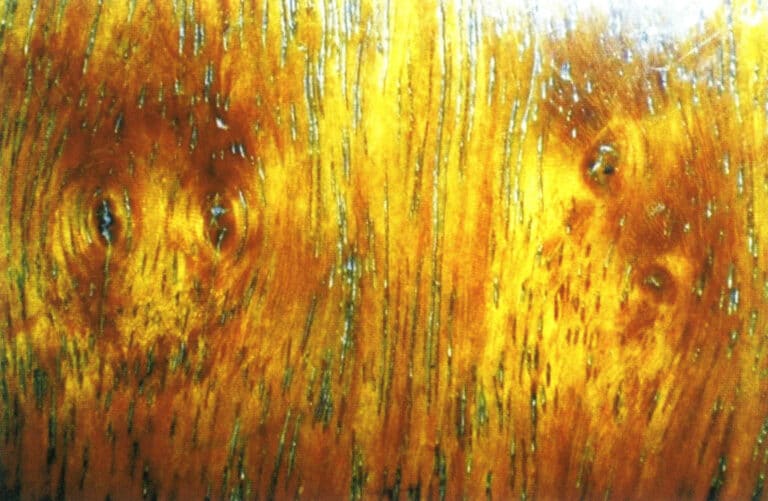
3. Classification of Hainan Huanghuali
(1) Classified by Heartwood
The heartwood of Hainan Huanghuali is continuously transformed from the sapwood, with a rich variety of colors varying in depth and size. The heartwood is commonly referred to as “grain,” with larger heartwood called “resin-saturated grain” and smaller heartwood called “porous grain.” The heartwood comes in various colors: light yellow, golden yellow, orange-yellow, reddish brown, purplish red, and dark brown. Typically, resin-saturated grain appear dark brown, while porous grain appears reddish or purplish brown. Different colors also correspond to the wood’s relative density, oiliness, and aroma variations. The deeper the color, the higher the relative density; the greater the oiliness, the stronger the scent of sandalwood; conversely, if the heartwood color is lighter, the relative density and oiliness are lower, and the scent of sandalwood is relatively faint.
(2) Classified by Oiliness
The differences in color and oiliness of Hainan Huanghuali can be divided into three categories: Yellow Huanghuali, Butterfat Huanghuali, and Resin-saturated Huanghuali .
Yellow Huanghuali is actually what people commonly refer to as “Porous Huanghuali.” When old Resin-saturated Huanghuali is left for a long time, through oxidation, the oil and moisture inside the wood gradually diminish. Although the Resin-saturated Huanghuali can still be vaguely identified from the grain, the wood has become rough and rotten. This kind of Hainan Huanghuali is porous Huanghuali. Most Yellow Huanghuali has a lighter color and a higher oil content, and to distinguish it from the darker porous Huanghuali, it is called Yellow Huanghuali. The main characteristics of Yellow Huanghuali are clear and smooth grain and light color, primarily with circular patterns.
Butterfat Huanghuali is a term that has only been used in recent centuries, and it was developed due to the actual market for redwood. Butterfat Huanghuali maintains the brightness and charm of Yellow Huanghuali in terms of texture and lines, but its overall color leans towards yellow-brown, and in some places, it appears dark brown. The biggest difference between Butterfat Huanghuali and Yellow Huanghuali is that Butterfat Huanghuali is mainly characterized by ghost faces, with more enchanting and profound textures, and it is also richer in oiliness compared to Yellow Huanghuali. Many exquisite tiger stripe patterns come from Butterfat Huanghuali.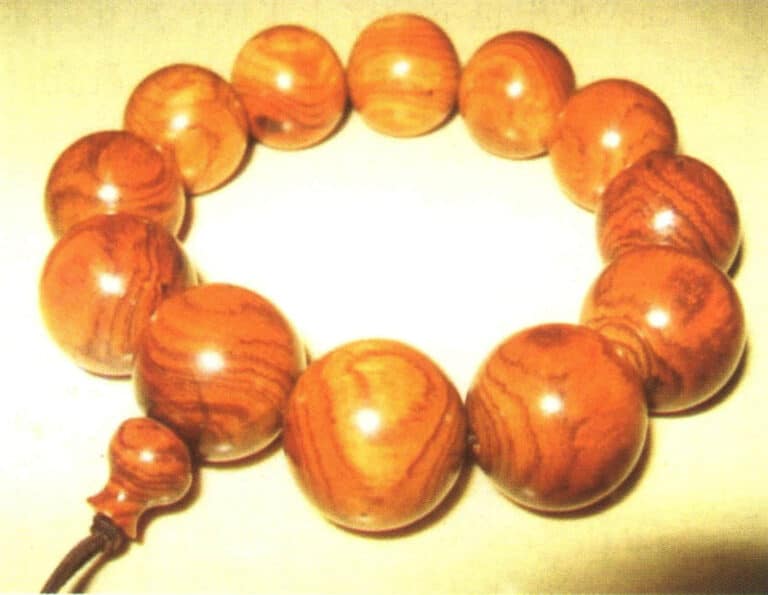
Yellow Huanghuali

Butterfat Huanghuali
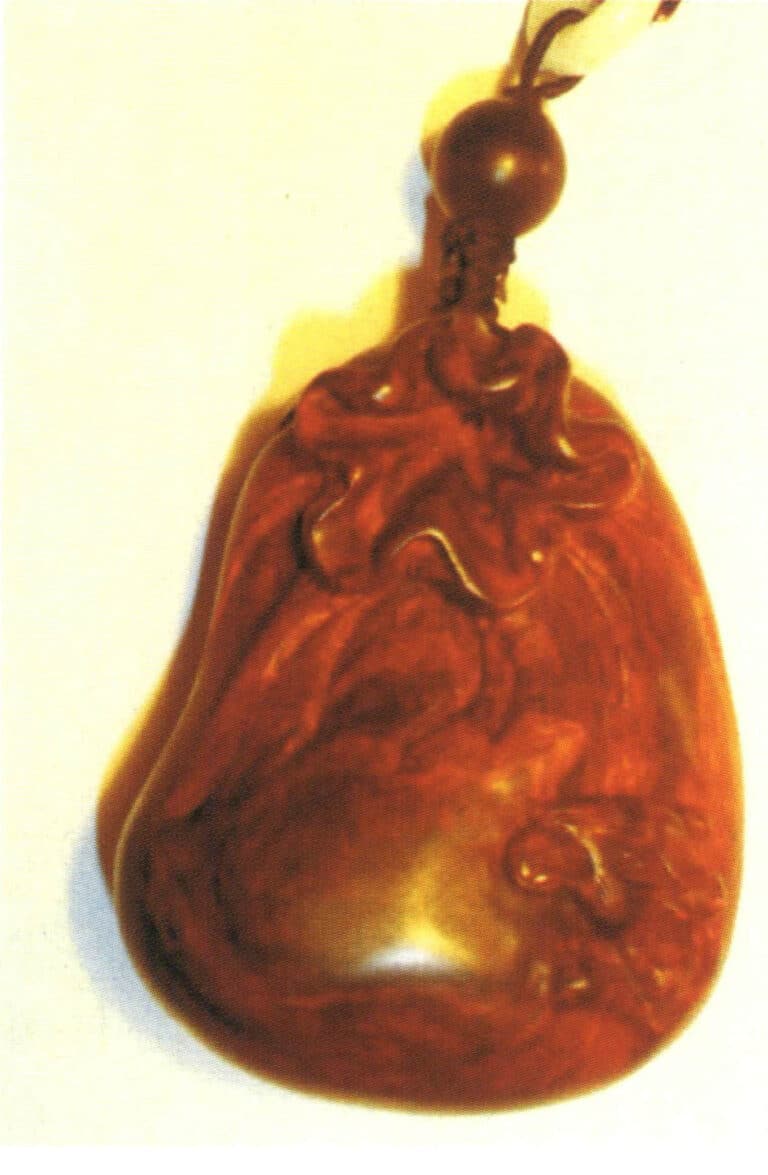
4. Huanghuali Wood Ornaments
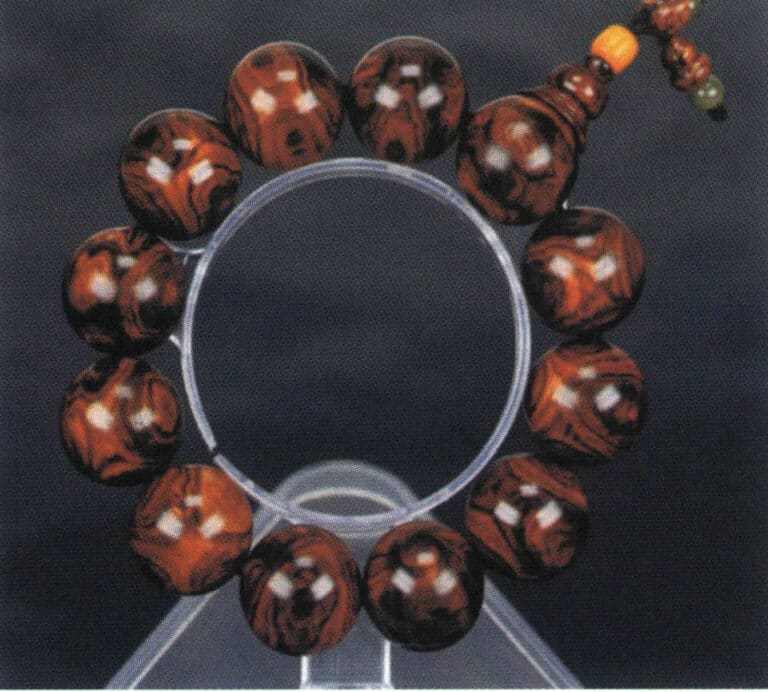
Bracelet made of Hainan Huanghuali
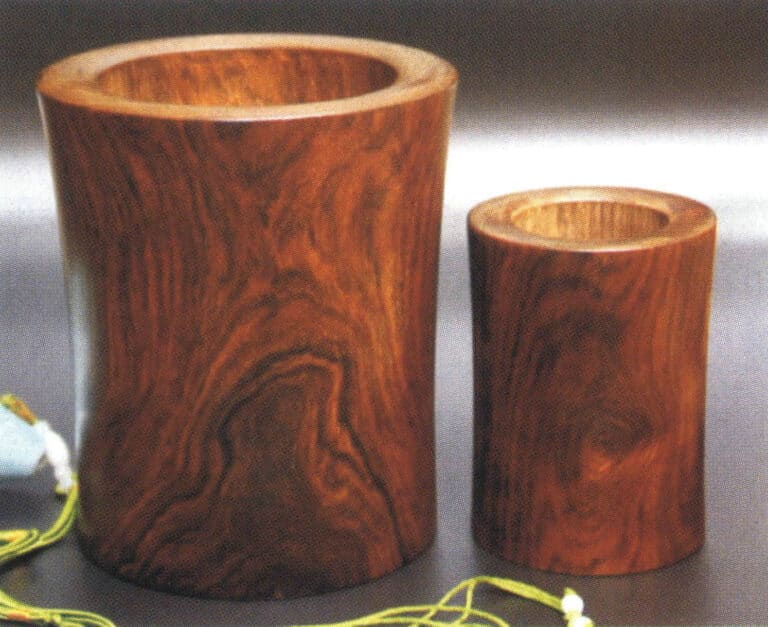
Crafts made of Hainan Huanghuali
Section III Ancient Sunken Wood and Its Ornaments
1. Introduction to Ancient Sunken Wood
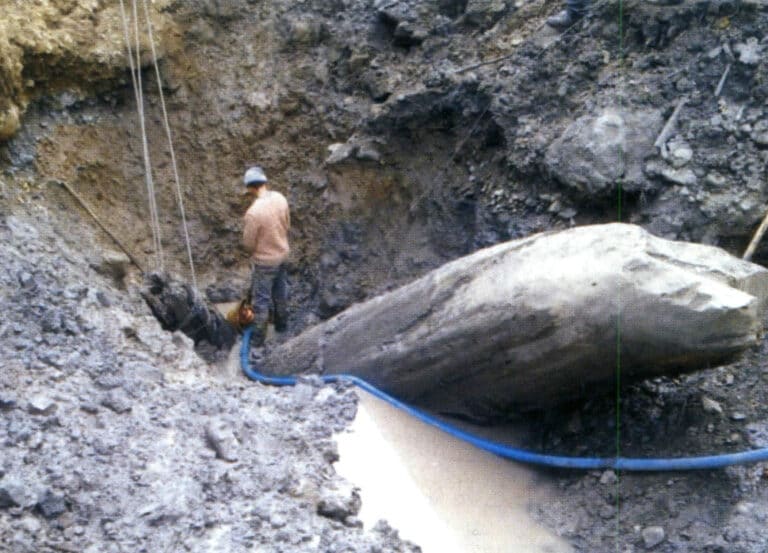
Ancient sunken wood does not refer solely to one type of wood, such as cedar, but is a collective name for various types of wood buried underground and not decayed, which can be used for making objects. Many varieties of ancient sunken wood include cypress, China Fir, Nanmu, Wild Lychee, Bitter Tzu, Green Nanmu, and Ironwood. The term “ancient sunken wood” is known by different names in various regions; in the Songhua River basin of Northeast China, it is called “wave wood” or “sinking river wood,” while in Sichuan, it is referred to as “black wood” (the color of sinking wood is generally dark). These types of wood share common characteristics: they are hard, moisture-resistant, insect-resistant, rot-resistant, and fragrant, with a heavy oil content. Their colors vary due to different ages and degrees of carbonization; ancient sunken wood is black and shiny, very luxurious.
The reasons for the formation of ancient sunken wood are generally believed to be natural variations in celestial bodies, where earthquakes, floods, and mudslides bury all terrestrial plant life into ancient riverbeds and other low-lying areas. Some trees buried in silt undergo a carbonization process over thousands or even tens of thousands of years under anaerobic and high-pressure conditions, aided by bacteria and other microorganisms. Thus, they are also known as “carbonized wood.” Ancient sunken wood has endured the vicissitudes of time, subjected to various external and internal forces of nature, resulting in its bizarre, ancient, and elegant natural shapes. It is no wonder that foreigners, after visiting, marvel at it as the “sacred wood of the East.”
2. Ancient Sunken Wood Craft Ornaments
The essence of ancient sunken wood is hard, often manifests in dark brown, black-red, golden, and yellow-brown colors. Its cut surface is smooth, with fine wood grain, and if polished properly, it can achieve a mirror-like shine. Some ancient sunken wood is nearly similar to red sandalwood in essence.
Because ancient sunken wood is a non-renewable resource, its development is decreasing, and some naturally shaped ancient sunken wood artworks have significant collectible value. Throughout history, ancient sunken wood has been used as a talisman and crafted into handicrafts, Buddha statues, amulets, and other items. The ancients said: “Having half a piece of black wood at home is better than a treasure chest.” The excellent properties of ancient sunken wood have also led to its use in jewelry making. Some examples of ancient sunken wood craft jewelry are as follows.

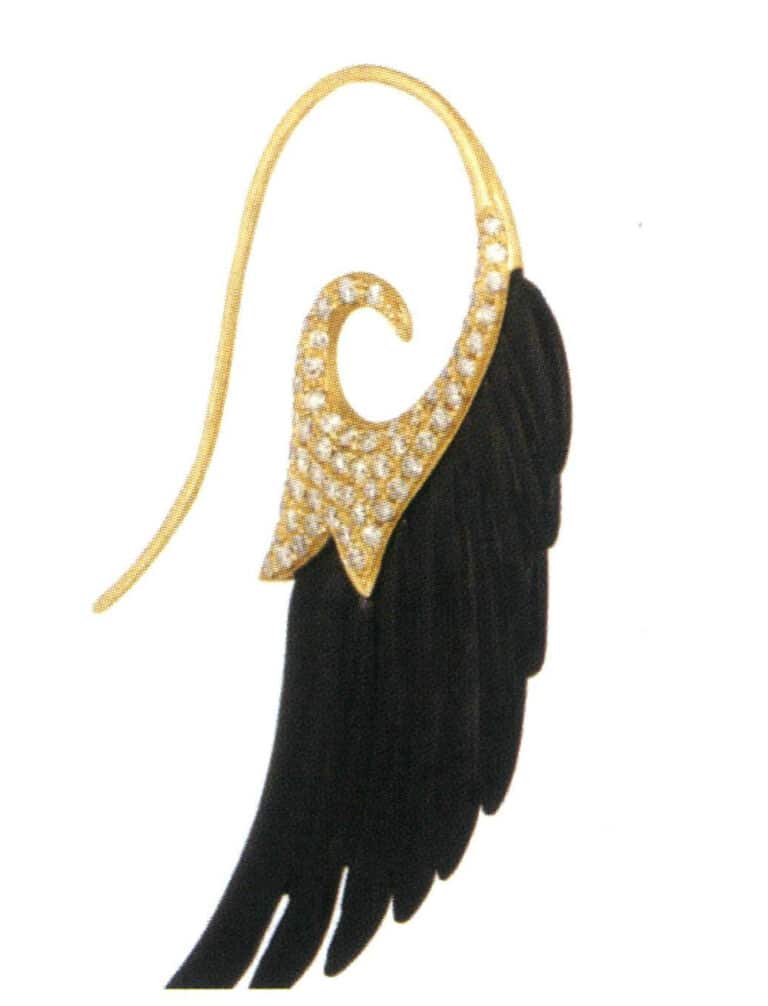
18K diamond inlaid ancient sunken wood earrings
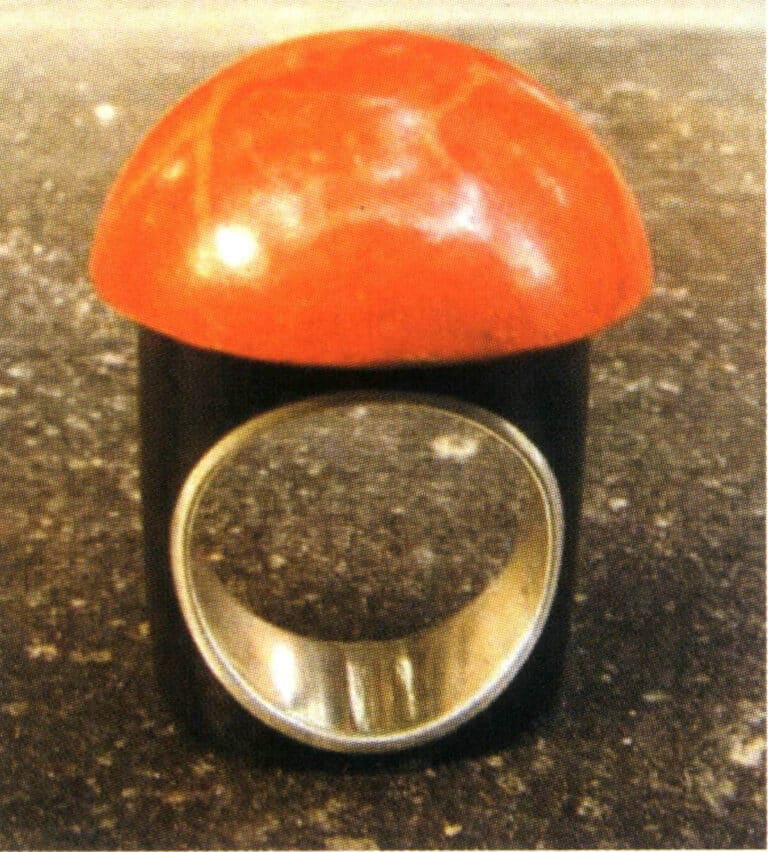
925 silver ring inlaid with ancient sunken wood
Kopírování @ Sobling.Jewelry - Výrobce šperků na zakázku, továrna na šperky OEM a ODM
Section IV Rosewood and Its Ornaments
1. Introduction to Rosewood
Since ancient times, China has had a tradition of valuing rosewood and is one of the earliest countries to recognize and develop it. The name “rosewood” first appeared during the Jin Dynasty 1500 years ago, recorded in Cui Bao’s “Ancient and Modern Annotations,” which stated, “Rosewood, produced in Funan, is purple in color, also known as black sandalwood.” The character “purple” symbolizes auspiciousness, and combined with the unique excellent wood properties and rarity of rosewood, it was highly valued by the royal family during the Ming and Qing Dynasties. The emperors of both dynasties spared no expense, gathering skilled craftsmen from around the world to create various rosewood furniture and ornaments. By the end of the Ming Dynasty and the beginning of the Qing Dynasty, the vast majority of rosewood produced worldwide had gathered in China and stored in Guangzhou and Beijing.
Rosewood is mainly divided into black rosewood and red sandalwood. Black rosewood is commonly known as Louvel’s rosewood, belonging to black acidwood. It has larger and rougher pores than the latter, and its growth rings are not obvious. In terms of physical characteristics, its air-dry density, bending strength, elastic modulus, and longitudinal compressive strength are all inferior to that of red sandalwood. Red sandalwood, commonly known as rosewood, is one of the most precious woods in the world, mainly produced in India, the Malay Peninsula, the Philippines, and, to a lesser extent, in Hunan, Guangdong, and Yunnan in China. Red sandalwood grows slowly and takes a long time to mature, so its diameter is generally small, usually within 20 cm; larger pieces tend to be hollow and unusable. Among various hardwoods, Indian red sandalwood has the finest texture and the heaviest weight, sinking in water. There is a saying, “Nine out of ten Rred sandalwood are hollow,” indicating its preciousness. Figure 10-2 is an example of red sandalwood logs.
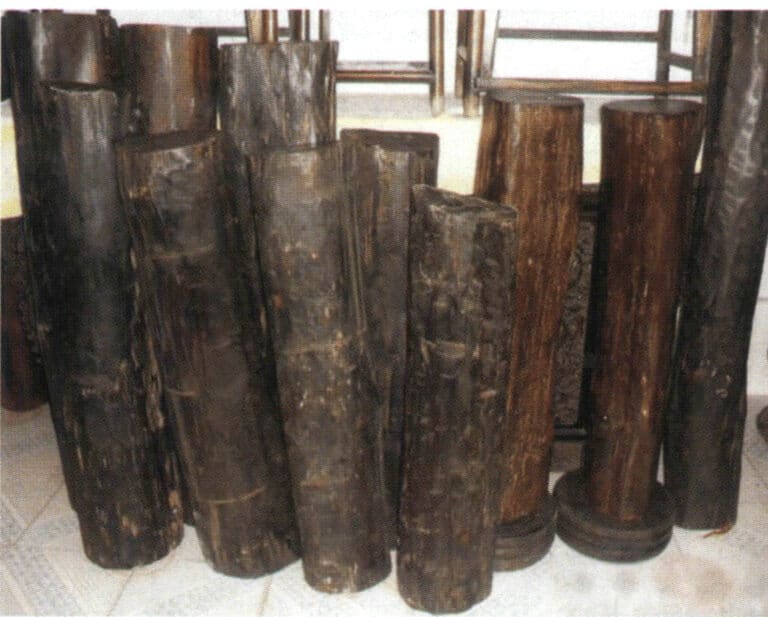
Due to the world’s preference for red sandalwood, many other types of wood are mixed in, with the most notable being black rosewood pretending to be Indian red sandalwood. Red sandalwood has distinct characteristics, and the main ways to distinguish the two are as follows.
- The vessels of red sandalwood are filled with red resin and sandalwood essence, while the vessels of black rosewood have a darker color and a greater contrast with the original color.
- Red sandalwood has a high density and sinks in water, while black rosewood sometimes sinks in water and sometimes floats.
- The surface material of red sandalwood is mostly purple-red or deep purple-red, while the freshly cut surface of black rosewood is orange-red, and after a long time, it becomes deep purple or a dark coffee color.
- Red sandalwood has a fluorescent reaction (Figure 10-3), while black rosewood does not.
- Red sandalwood has a stronger oily texture, but the oily texture of black rosewood, which is lighter in weight, is weaker.
- Red sandalwood has no fragrant smell or is very weak, while black rosewood has a sour fragrance.
- The texture of red sandalwood is relatively straight with fewer patterns, while black rosewood has obvious patterns and is locally curled.

2. Rosewood Craft Ornaments

Red sandalwood hairpin
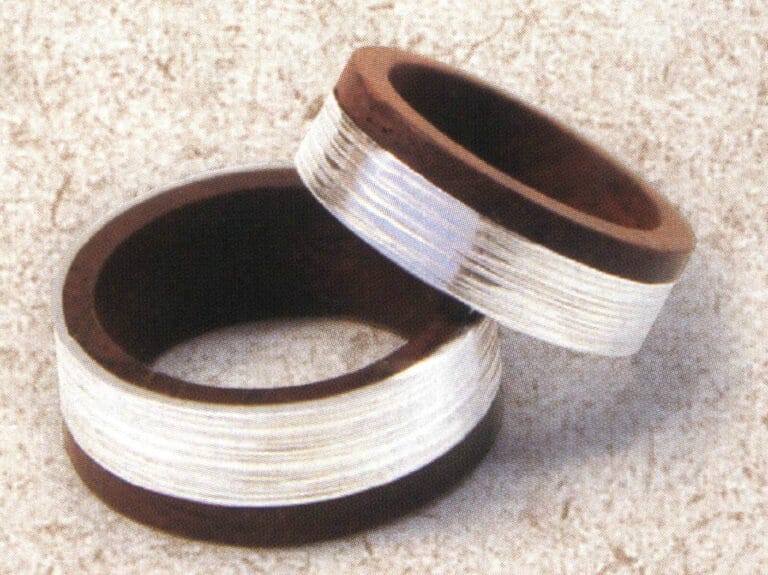
Red sandalwood inlaid silver ring
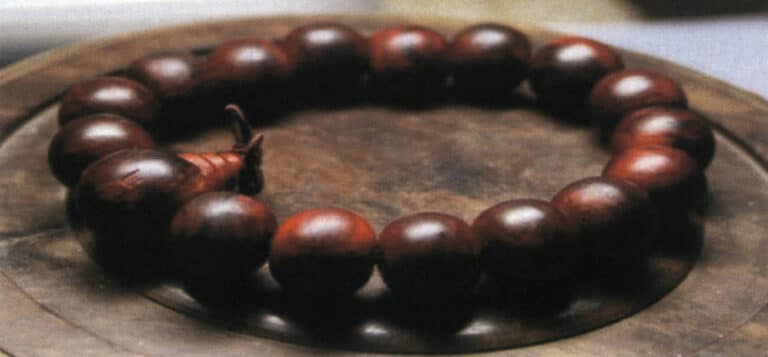
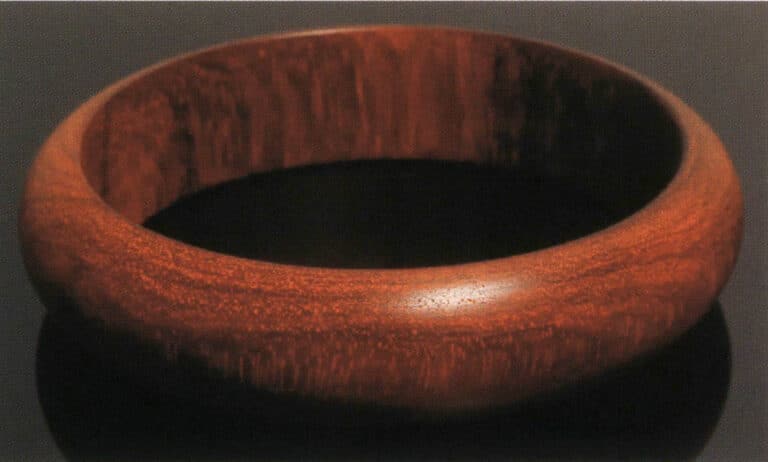
Red sandalwood bracelet

Red sandalwood pendent
Section V Golden Nanmu and Its Ornaments
1. Introduction to Golden Nanmu
Golden nanmu is a general term for a nanmu type with golden threads and a satin-like luster among certain materials. It is a precious wood unique to China and is classified as a national second-level protected plant. It is mainly distributed in the subtropical regions of Sichuan, Guizhou, Hubei, and Hunan in China, particularly in damp valleys, low-lying areas, and along rivers at altitudes of 1000~1500m. The climate here is warm and humid, free from the severe winds and snowstorms of high-latitude regions and the scorching heat of tropical rainforests, making it a typical subtropical monsoon climate. The unique natural environment and climatic conditions give golden nanmu warm, gentle, and neither dry nor humid wood characteristics. Golden nanmu is stable, does not warp or crack, is durable, and has a fresh and pleasant fragrance. Since ancient times, it has been said that “water cannot soak it, and ants cannot burrow into it.”
The color of golden nanmu wood is generally yellow with a hint of light green. Still, after oxidation, it can display various colors, including golden yellow, light yellow, green, purplish red, and black. The golden silk in golden nanmu wood is a crystalline substance formed from the cell sap of nanmu wood after prolonged oxidation. This crystalline substance can reflect light from multiple angles, making the surface of the wood shimmer in the sunlight, with golden silk appearing and a subtle fragrance emanating. Therefore, while many nanmu woods may have varying amounts of golden silk, not all nanmu woods meet the standards to be classified as golden nanmu wood. For nanmu wood to qualify as golden nanmu wood, it must meet the following requirements: under light, the texture must be crystal clear or semi-transparent; the quality of the golden silk must be very high, with the crystallization rate of the entire piece of wood reaching or above 80%, and under light, there should be a fantastical effect of changing scenery with every step; the wood grain must exhibit auspicious patterns, such as tiger skin patterns, phoenix patterns, rosy clouds, sea of clouds, waves, peaks, etc.
2. The Texture of Golden Nanmu
The texture of golden nanmu is rich and varied. With its unique shifting shadows (the wood has two sides of yin and yang, showing different colors at different angles), its value is proportional to its texture; the more beautiful and rare the grain, the higher its value. It is divided into four levels: ordinary, medium, fine, top-grade, and rare.
- Ordinary patterns include golden silk patterns, checkered patterns, and peak patterns patterns.
- The medium-level textures include ordinary water wave patterns, new material black tiger skin patterns, golden peak patterns, and peak patterns that form a pictorial effect.
- The premium textures include old black tiger skin pattern, gold tiger skin pattern, gold line pattern, gold ingot pattern, cloud pattern, water droplet pattern, bubble pattern, etc.
- The premium textures include premium water ripple, premium wave pattern, phoenix tail pattern, dense water droplet, golden chrysanthemum pattern, sesame dot wood, ding ding nan cloud pattern, etc.
- The rare textures include a gentian pattern, dragon scale pattern, golden jade full hall pattern, rose pattern, grape pattern gnarled wood, and textures of beautiful scenery and bird and beast patterns.

Superb water ripple pattern golden nanmu
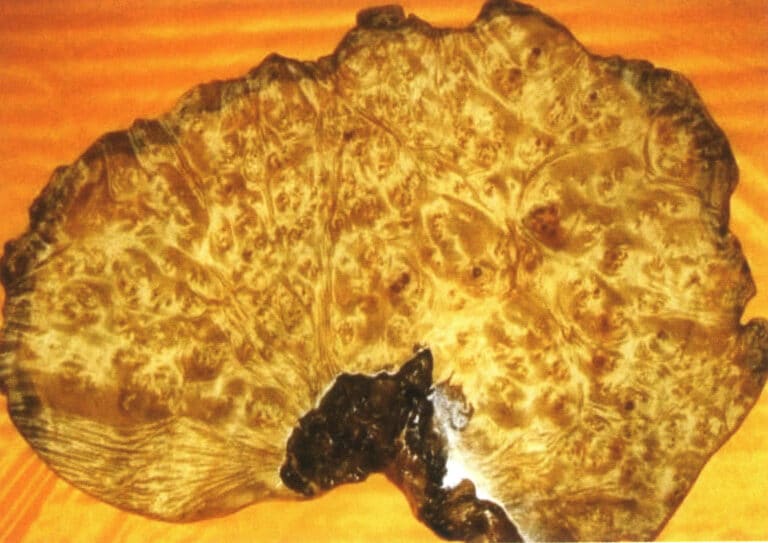
Grape-patterned golden nanmu
3. Golden Nanmu Craft Ornaments


Zlatý náramek nanmu
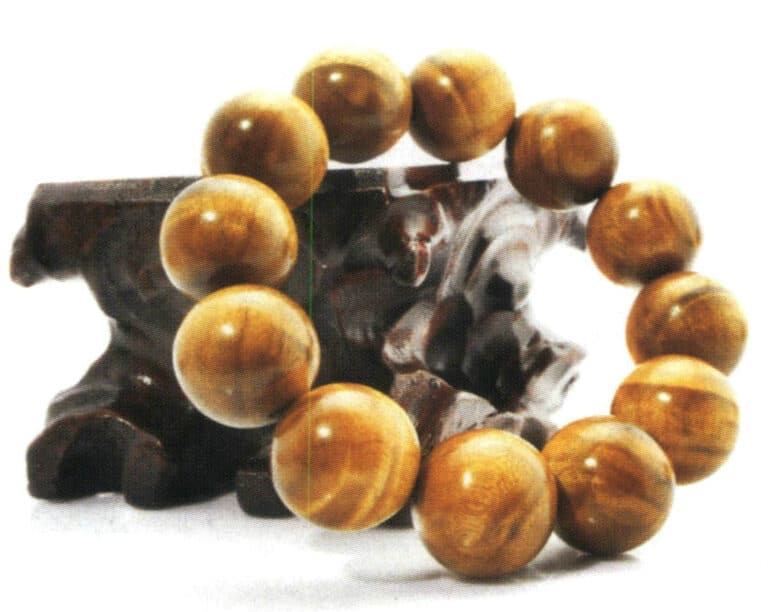
Zlatý náramek nanmu
Section VI Petrified Wood and Its Ornaments
1. Introduction to Petrified Wood
Petrified wood, like other fossils of plants and animals, is a very precious geological paleobiological relic resource, belonging to the invaluable and non-renewable natural heritage left to us by nature. Due to its significant scientific research, popular science education, and tourism value, petrified wood has increasingly attracted widespread attention from the scientific community and various sectors of society. China is one of the regions in the world where petrified wood is widely developed, and there have been discoveries and reports of petrified wood fossils in nearly 20 provinces and autonomous regions across the country. Its distribution covers Liaoning, Heilongjiang, Jilin in Northeast China; Inner Mongolia, Beijing, Hebei, Shanxi in North China; Xinjiang, Gansu, Shaanxi in Northwest China; Sichuan, Chongqing, Yunnan in Southwest China; Hubei, Hunan, Guangdong, Guangxi in South China; and Zhejiang and Shandong in East China. In terms of the scale and preservation status of petrified wood, the most representative sites include Qitai in Xinjiang, Yanqing in Beijing, Xinchang in Zhejiang, and Shehong in Sichuan, all of which have been approved as national geological parks.
The formation process of petrified wood is very long. About a 1.5~3 hundred million years ago, during the late Paleozoic and Mesozoic eras, the earth’s land was covered by dense vegetation with a rich diversity of ferns and gymnosperm forests. Especially during the late Jurassic period, about 150 million years ago, tall and lush gymnosperms flourished and became the dominant type of higher terrestrial plants on earth.
However, with the impact of geological activities such as volcanic eruptions caused by tectonic movements, forest fires, large-scale transgressions and regressions, heavy rain and floods, and large-scale mudslides, some forests have been buried in underground strata, isolating the trees from the air for a long time. Through a long process of petrification, they have formed what is known as “ancient stone trees,” represented by the trunks of plants. Petrification mainly refers to silicification, which can be further subdivided into mineralization-silicified wood and carbonization-silicified wood. Regardless of the type, all petrified wood relies on the action of silica.
When plant stems and other parts are buried underground for a long time, a silica-rich aqueous solution enters the tubular molecules inside the wood. All the moisture and nutrients in the wood’s internal structure are replaced by SiO2 through a replacement process. The anatomical structure of the wood, cell morphology, and the external bark and tree roots can be preserved for a long time after being silicified, forming a hard-textured wood fossil, which is commonly referred to as “petrified wood.”
Petrified wood is usually preserved in large stems of fossilized trees, and some also preserve the plants’ root systems and other nutritional organs. The trunks of wood fossils are often found in a fallen state, some parallel to the surrounding strata, with preserved lengths varying greatly, ranging from several centimeters to several meters; some stems are preserved upright on the ground, mainly the lower part of the tree near the roots, often as stumps or tree bases. In most cases, smaller wood fossils are preserved in fragmented form due to long-distance transport or migration through water. Additionally, when the burial and preservation conditions are favorable, even the external morphology of the fossilized trunks, resembling the “bark” imprints of modern trees, can be preserved.
2. Petrified Wood Craft Ornaments
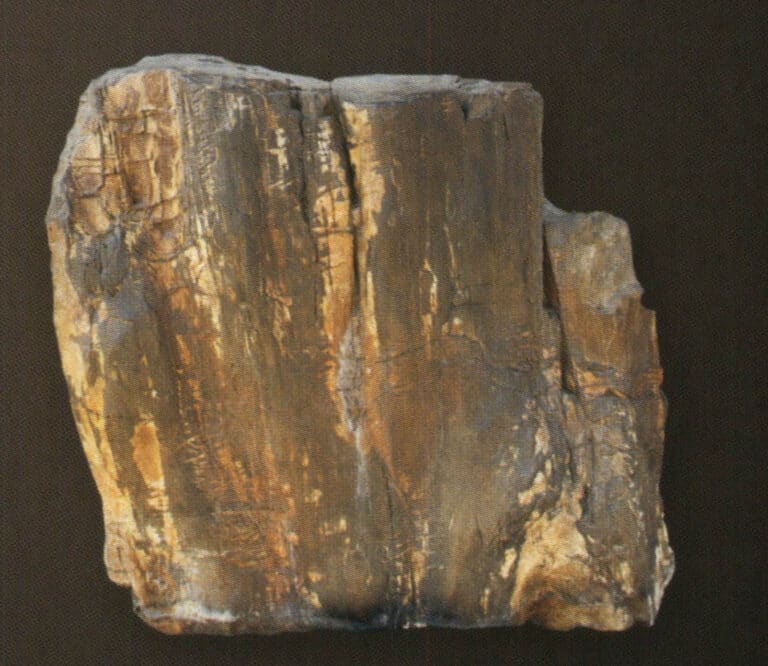
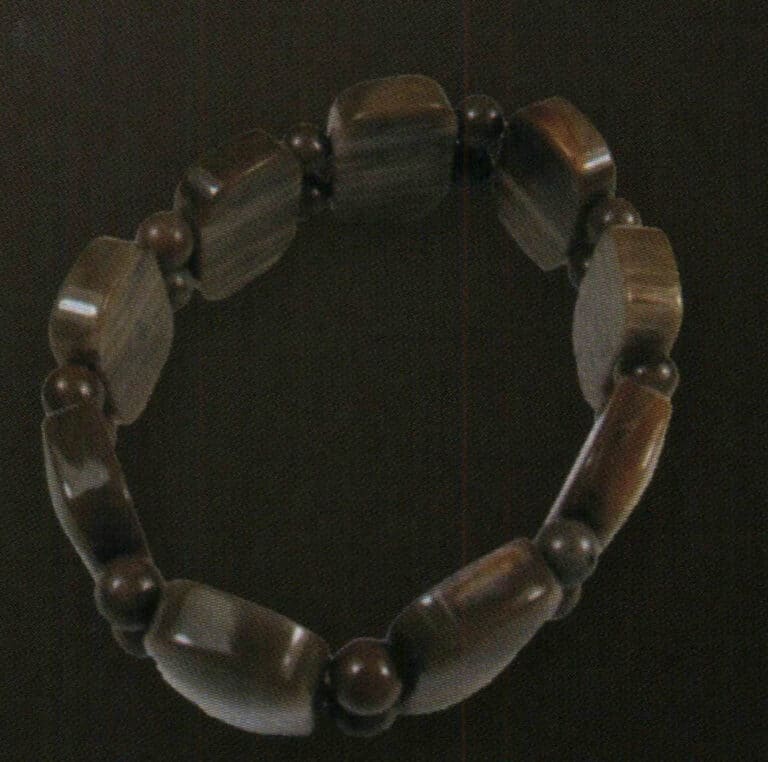
Petrified wood bracelet

Petrified wood bracelet
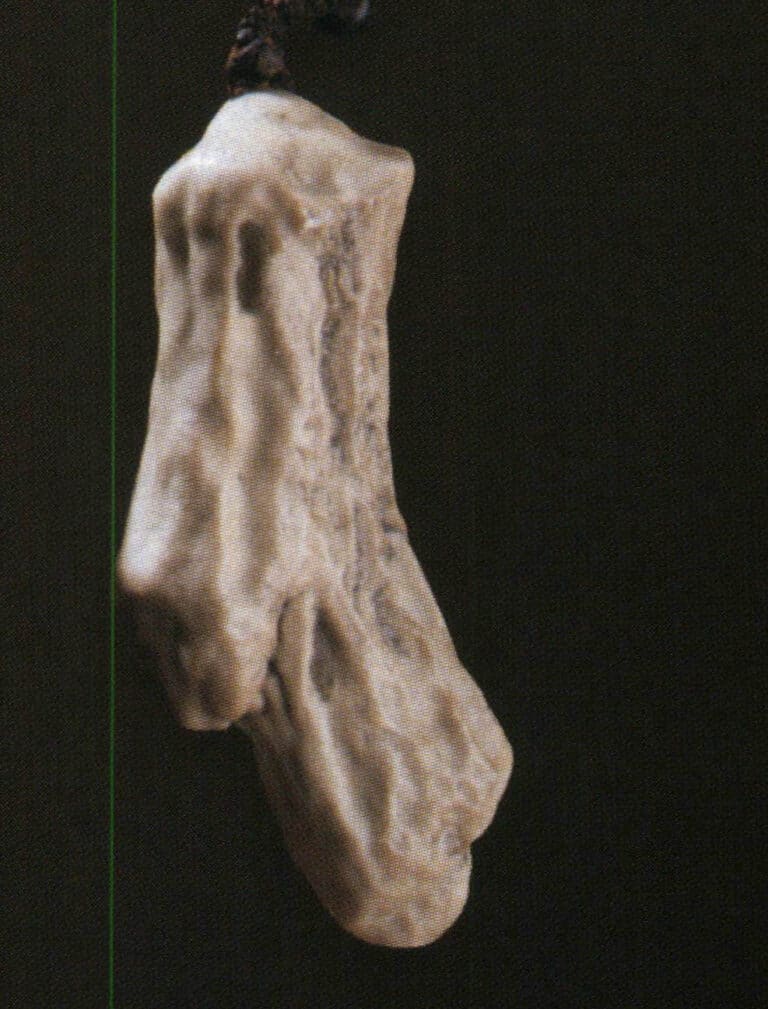
Zkamenělé dřevo
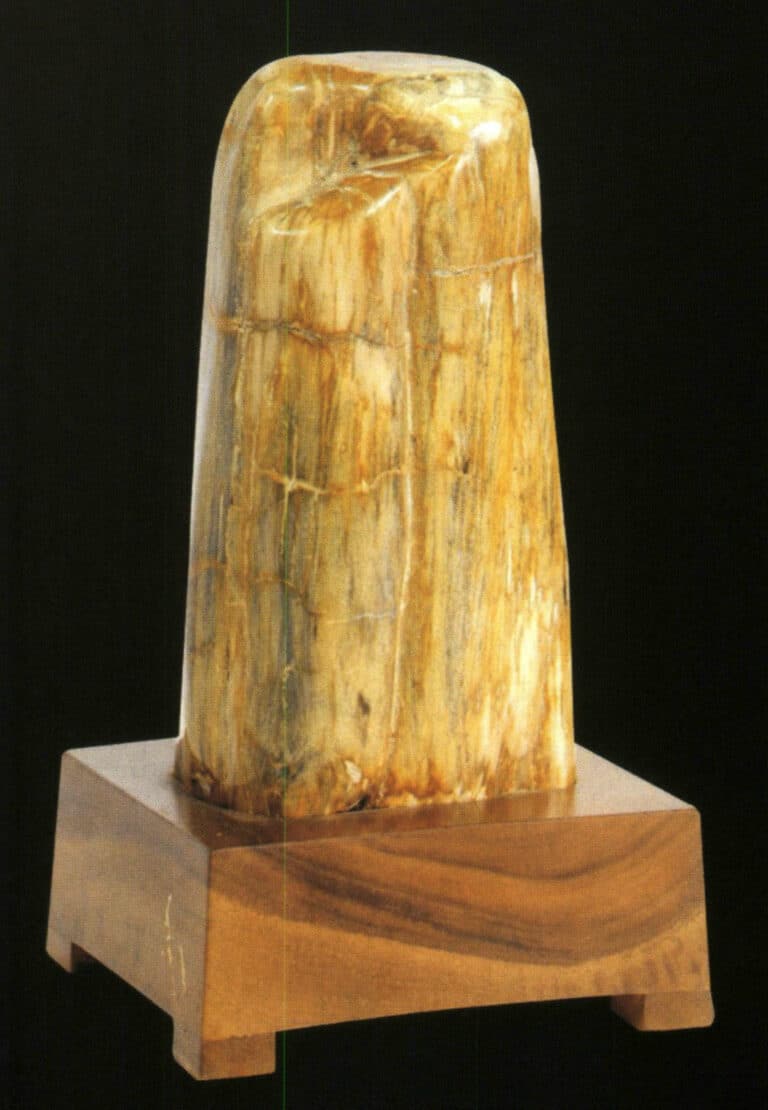
Petrified wood ornament
Section VII Production Process of Wooden Craft Products
1. General Production Process of Wooden Craft Ornaments
Generally speaking, the production of wooden craft ornaments generally goes through about 10 processes.
(1) Design. According to the needs of customers and the market, professional designers create jewelry samples and make prototypes, and production technicians design the process flow and production operation flow.
(2) Material selection. Choose the appropriate wood according to the needs of the artistic design.
(3) Cutting. Perform preliminary processing on the selected wood, cutting it into boards or wire products, and then shape the material.
(4) Shaping. There are many types of wood, and many kinds of wood are prone to deformation due to factors such as fiber structure, material, and moisture content after initial processing. Different materials require corresponding methods for shaping, with the main methods being soaking in water, pressing flat, roasting, steaming, and setting. Some woods also require processes such as sugar removal and deodorization; for example, bamboo and birch contain high sugar content, making them susceptible to insect damage, so sugar removal is necessary, while materials like pine and camphor require the extraction of rosin and camphor oil; otherwise, the scent of rosin and camphor oil in the accessories will be too strong and unsuitable for wearing.
(5) Finishing. Cut the shaped wood according to the process design requirements, processing it piece by piece into primary artistic shapes. The processing methods mainly include sawing, cutting, grinding, milling, drilling, carving, and embossing.
(6) Polishing. The surface polishing treatment of the initially formed jewelry pieces involves three main steps: first, deburring, which cleans up the burrs, sharp edges, wood chips, etc., on the initial jewelry pieces; second, rough polishing, which uses coarse sand materials to polish the jewelry components, making the surface smooth; third, fine polishing, which uses fine sand materials, hair, silk, cotton, linen, and other fine fiber materials for high gloss polishing.
(7) Surface decoration processing. The surface-treated accessory components are artistically produced, mainly using drawing, transfer printing, dyeing, engraving, and embossing to create artistic accessory components, making them qualified accessory components.
(8) Assembly. Assemble decorative accessories and various auxiliary components, such as beads, prongs, chains, threads, wires, knots, hairpins, bracelets, buckles, hooks, etc. according to the craft design drawings, using various methods such as tying, connecting, stringing, buckling, welding, and gluing to assemble them into finished jewelry products.
(9) Inspection. Different technical requirements must be inspected during each process, from art design to assembly. In addition to standard inspections, technical inspections in health, environmental protection, and safety areas must also be conducted.
(10) Balení. Package the finished jewelry products.
2. Production Process of Wooden Bead Bracelets
Taking a red sandalwood bead bracelet as an example, the production process is as follows.
(1) Material selection. In the wooden bead bracelet processing industry, especially in the processing of red sandalwood, the most important thing is material selection. There is a saying, “Nine out of ten red sandalwood are hollow,” so when buying wood, one should consider the appearance and consider the appearance and estimate whether the wood is hollow based on its volume, weight, density, and other factors.
(2) Slicing. Slice according to the size of the wooden beads to be made, leaving a processing allowance during slicing (Figure 10-4).
(3) Sticking round pieces or drawing circles. Based on the shape of each wooden piece, draw circles or stick round paper pieces on the wooden piece as a reference for cutting (Figure 10-5). When drawing circles, consider their layout to maximize the number of circles and improve the utilization of the wood. For flawed wood with knots, voids, cracks, etc., avoid these defects when drawing circles to prevent affecting the quality of the wooden beads. At the same time, be sure to leave a certain distance between each circle as a margin for sawing.

Figure 10-4 Wood slicing
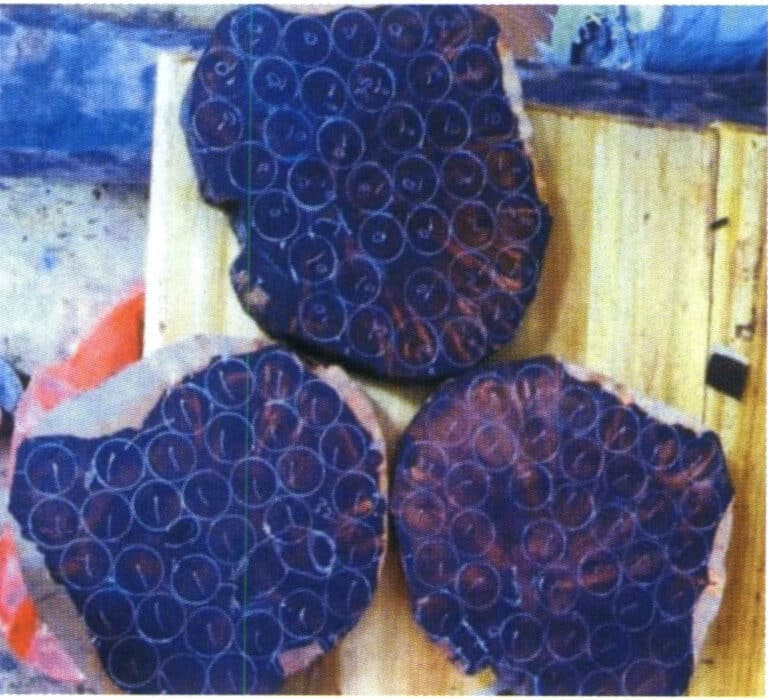
Figure 10-5 Drawing circles on the wood pieces for cutting
(4) Cutting raw materials. According to the outlined circle, cut the large wooden piece into small wooden columns (Figure 10-6). Tools such as band saws, rotary cutting tools with curved blades, and serrated steel pipes can be used for cutting, each with its characteristics. Band saws are generally used for mass processing because their blades are thinner than other methods, resulting in the highest wood yield for the same weight. The principles of the rotary cutting tools with curved blades and steel pipes are similar; both use a rotary cutting technique to turn the wooden piece into small columns or beads, making the operation simple. The advantage of the cutting tool is that it can directly produce beads, eliminating the step of grinding the column into beads. The columns produced by the steel pipe are very regular, facilitating the next processing step. However, the tools used in these two methods have their fixed thickness, so they will result in more waste of raw materials.
(5) Drilling. Simple drilling tools can be used to drill holes in small wooden posts, with the holes’ size determined by the ropes’ thickness and number. When drilling, it is important to control the verticality of the wooden post to prevent the holes from being misaligned.
(6) Turning out the wooden beads. Choose the appropriate size of the turning tool based on the required bead size, with the tool’s edge being arc-shaped. Fix the small wooden post horizontally on the device and start the machine to rotate the wooden post at a certain speed. In contrast, the adjacent turning tool continuously rotates, cutting the wooden post into beads (see figure 10-7). The contact between the wooden post and the turning tool will inevitably generate heat during cutting, so adding water droplets above the wooden post is necessary. This can lower the temperature of the beads and replenish the moisture evaporated from the surface of the beads due to high temperatures, preventing cracking caused by inconsistent density stress inside and outside the wooden beads.
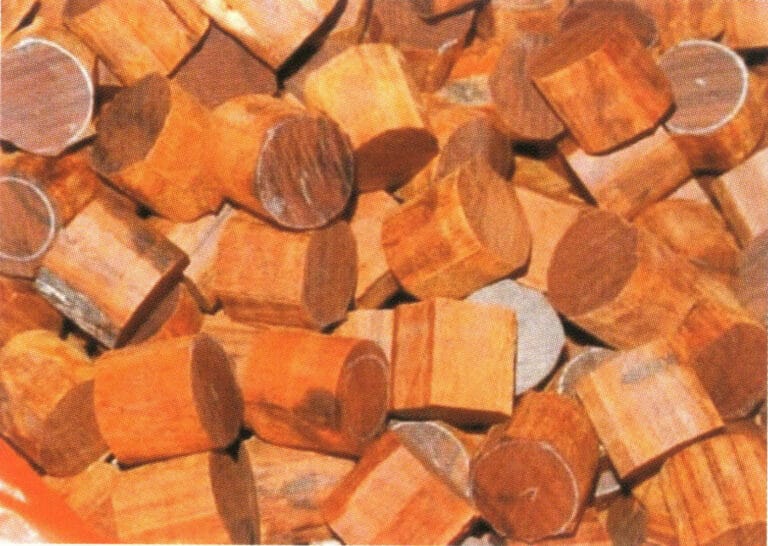
Figure 10-6 Sawing and Cutting Material
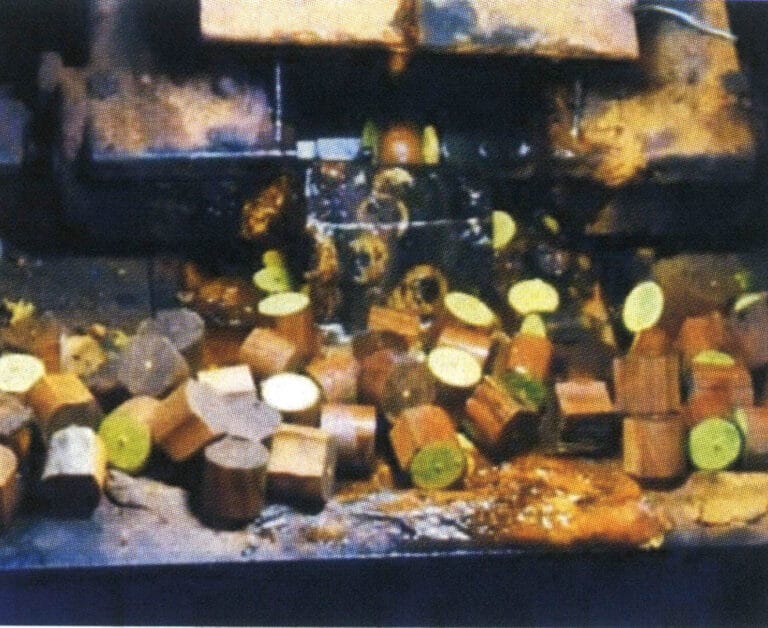
Figure 10-7 Unscrewing the beads
(7) Making a three-way Buddha head. Each bead bracelet needs to be paired with a three-way Buddha head, which can be selected from the bead pile, and a three-way hole is drilled on the drilling machine (Figure 10-8).
(8) Polishing. Use coarse to fine sandpaper to polish the wooden beads’ surface (Figure 10-9). The finer the polishing, the more oil is extracted inside the wooden beads.

Figure 10-8 Drilling three-way hole
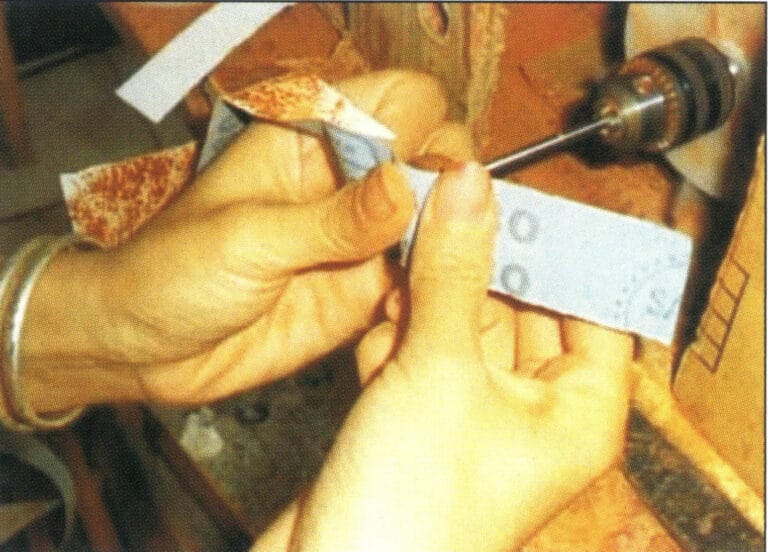
Figure 10-9 Polishing the surface of the bead
(9) Finished round beads. As shown in Figure 10-10.
(10) Using elastic rope to thread through wooden beads to make a bracelet.
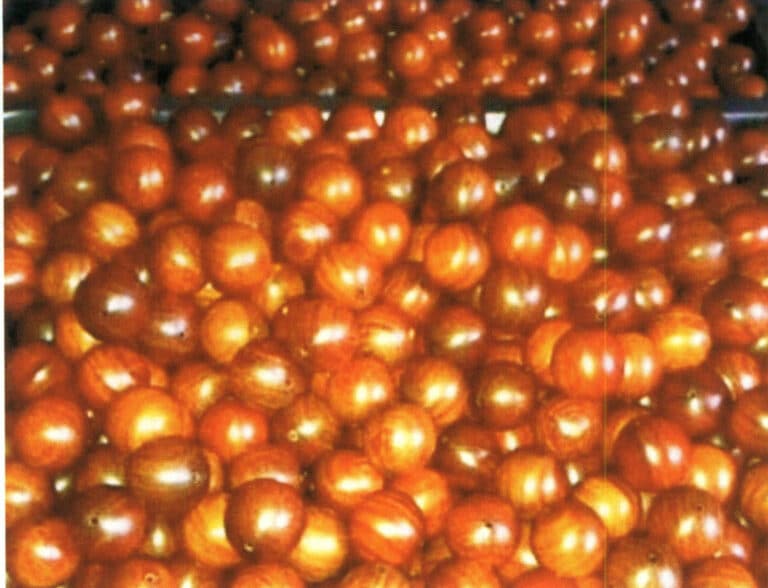
Kopírování @ Sobling.Jewelry - Výrobce šperků na zakázku, továrna na šperky OEM a ODM






